Eye color varies dramatically in owls. It can range from black, brown, orange, yellow, to green, and some other variations. The color of an owl’s eyes depends on the pigments and light refraction, just like the color of their plumage.
According to a 2018 study, most owls with yellow-colored pupils are diurnal (most active during the day) while those with darker ones are nocturnal (most active during the night), with some exceptions.
Examples of owls with yellow eyes include the snowy owl, great horned owl, great gray owl, burrowing owl, short-eared owl, and many others.
In this article, you will learn what each of these looks like and how to best identify them in nature.
Table of Contents
Owls With Yellow Eyes
1. Elf Owl
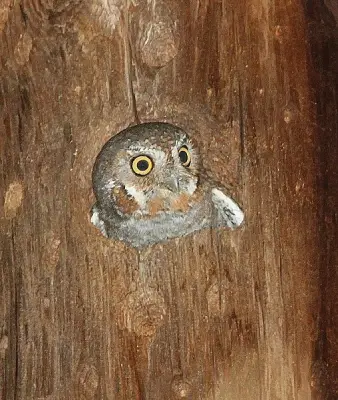
- Scientific Name: Micrathene whitneyi
- Length: 4.9-5.7 in
- Weight: 1.4 oz
These tiny grayish-brown birds are found in southwestern parts of the USA, central Mexico, and the Baja California peninsula. Elf owls have pale yellow eyes that are accentuated by their thin white “eyebrows”.
With an average weight of 1.4 oz and a length of 5.3 in, elf owls are one of the world’s lightest and smallest owls. These birds are strictly nocturnal – look and listen for them along a quiet desert or canyon road at night.
Elf owls hunt during the night on insects such as grasshoppers and scorpions, and mice and lizards. They love to nest in old woodpecker holes, high in the trees where larger predators like coyotes, bobcats, and snakes can’t get them.
Elf owls are monogamous but mostly for one breeding season. Females incubate the eggs while males feed them – to protect their fledglings from danger, they will clap their beaks, make loud barking sounds, and move their tails.
2. Ferruginous Pygmy-owl

- Scientific Name: Glaucidium brasilianum
- Length: 6.5-7 in
- Weight: 2.2-2.7 oz
Ferruginous pygmy-owls are crepuscular and nocturnal birds found in the Americas.
In the USA, they can be seen in southern Texas and south-central Arizona. These small owls are common in various semi-open wooded areas where they hunt for insects, mammals, birds, and lizards.
Ferruginous pygmy owls can be also located by a group of small birds mobbing them while perched in a tree (scientists have recorded many different species mobbing these owls).
Their plumage might vary from rusty to grayish; all morphs have fine whitish streaks on the crowns and narrow dark tail bars. Ferruginous pygmy owls have round yellow eyes as well as a pair of so-called false eyes – there are patches of dark feathers on the back of their heads that resemble real eyes.
3. Western Screech-owl
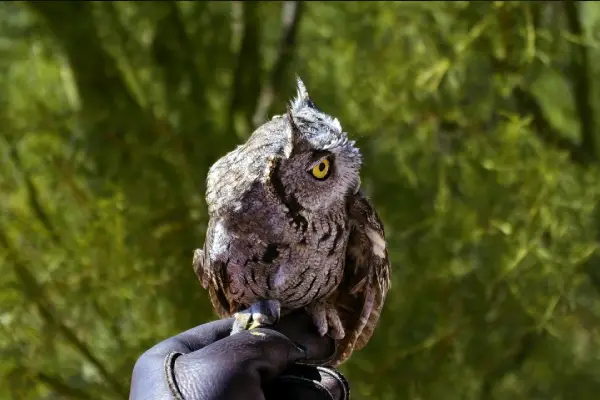
- Scientific Name: Megascops kennicottii
- Length: 8.7 in
- Weight: 5 oz
These small owls with stocky bodies are closely related to eastern screech owls and are native to North and Central America. Western screech owls can be found in different wooded habitats, but mostly prefer riparian and deciduous areas, as well as urban places and parks.
Western screech owls have gray plumage with black and white streaks, short ear tufts, and large yellow eyes. Part of their scientific name “kennicottii” is after the American naturalist Robert Kennicott.
The species are nocturnal, often seen sitting on perches before swooping down and catching their prey. They mostly feed on insects, small mammals, and birds – listen for their series of whistled notes that accelerate at the end that are given at night.
4. Eastern Screech Owl

- Scientific Name: Megascops asio
- Length: 6.3-10 in
- Weight: 4-8 oz
Eastern screech owls are small and stocky owls with big heads, large yellow eyes, often-raised small ear tufts, and horn-colored beaks. They are found in eastern parts of North America, in different habitats with trees and near water.
Eastern screech-owls are easier to hear than to see due to their small size and camouflage – they are most active at night when they hunt insects, small mammals, and birds. Their big eyes and sharp vision come in very handy for picking up small movements at night.
These owls are one of the most common birds found in northern Georgia and one of many night birds of Texas.
5. Northern Saw-whet Owl

- Scientific Name: Aegolius acadicus
- Length: 6.7-8.7 in
- Weight: 1.9-5.3 oz
These small owls native to North America are often found around coniferous and deciduous forests. With a length of 6.7-8.7 inches and a weight of 1.9-5.3 ounces, they are one of the smallest owl species there.
Northern saw-whet owls are mottled brown with white-spotted heads, whitish facial disks, yellow irises, and lack of ear tufts. They also have a distinctly white, Y-shaped coloration between their eyes.
What makes their flight feathers unique is the compound called porphyrin – the pigment gives their feathers a neon pink fluorescence when exposed to UV light. Northern saw-whet owls were named after their loud and repetitive whistles that are described as “a saw being sharpened on a whetstone”.
Strictly nocturnal and solitary, the species hunt at night from low perch and use sight and sound to locate their prey. Northern saw-whet owls are carnivores and mostly feed on mice, voles, lemmings, small birds, and some insects.
These owls are also common in Oregon.
6. Little Owl
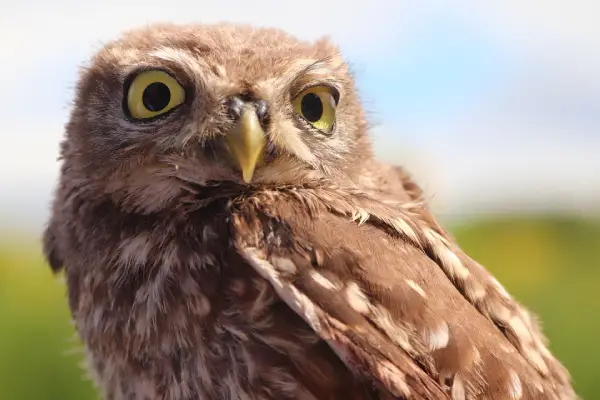
- Scientific Name: Athene noctua
- Length: 8.7 in
- Weight: 6.3 oz
These small owls are also known as owls of Athena and owls of Minerva and can be found in the open country of Europe, Asia, And Africa. They are common in semi-deserts, woodland fringes, steppes, and farmlands where they hunt for insects and earthworms.
Little owls are distinctive raptors with greyish-brown plumage that is spotted, streaked, and barred with white. They also have pale yellow eyes and white eyebrows.
Although mainly nocturnal, little owls can be also spotted during the day, often perching and hunting in their territories. If they spot intruders, they will first emit their harsh calls, fly at them aggressively, or attack with their talons.
7. Eurasian Pygmy Owl
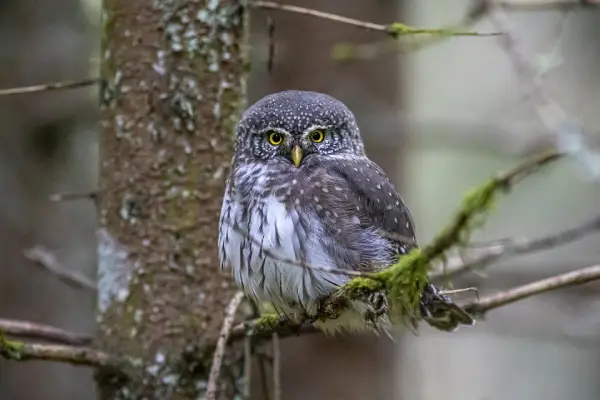
- Scientific Name: Glaucidium passerinum
- Length: 6-7.5 in
- Weight: 1.7-2.7 in
Eurasian pygmy owls are the smallest owl species in Europe. They have reddish-brown plumage with dots, white eyebrows, and fine spotting on their crowns.
Eurasian pygmy owls also have staring golden yellow eyes that look huge compared to their tiny heads. They also lack the ear tufts many other owls have.
These birds of prey are common in mixed and coniferous forests where they are most active during dusk and dawn (crepuscular animals). Eurasian pygmy owls feed on voles, bats, lemmings, mice, small birds, lizards, fish, and insects – they will store their food and use it during winter.
You can also check what these owls would look like with blue-colored irises.
8. Spectacled Owl

- Scientific Name: Pulsatrix perspicillata
- Length: 16-20.6 in
- Weight: 1-2.7 lb
Spectacled owls are large and unmistakable birds found in Central and South America. They are common in humid evergreen forests, often staying hidden in shady spots.
Spectacled owls are with dark brown bodies and very white to yellow-ochre-colored bellies – they also have light lines around their large bright orange-yellow eyes that look like “spectacles”.
Most vocal on calm, moonlit nights, their call consists of a series of deep hoots that is described as “a sheet of metal being flexed quickly” or “a hammer hitting a hollow tree”.
Spectacled owls are active during the night and these fast hunters have diets consisting of mice, bats, possums, and insects. They will swoop down on their prey before quickly returning to their perch.
9. Spotted Eagle-owl
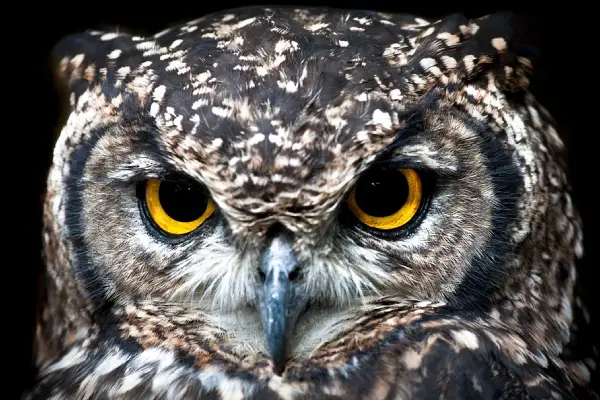
- Scientific Name: Bubo africanus
- Length: 18 in
- Weight: 1-2 lb
Spotted eagle-owls are the most common owl species in southern Africa, found in different habitats, including open scrubs, grasslands, and forest edges. They are also known as African spotted eagle-owls and African eagle-owls.
These large raptors have long ear tufts, mesmerizing bright yellow eyes, and dusky brown plumage with underparts that are off-white with brown bars. Their most common call is a soft booming sound that resembles “who-are-you“.
Spotted eagle-owls hunt rodents, birds, insects, small mammals, and reptiles, often swallowing their prey whole. They are monogamous species and mate for life, but if they lose their partners, these owls will find new ones shortly after.
10. Great Horned Owl

- Scientific Name: Bubo virginianus
- Length: 17-25 in
- Weight: 2.7-3.5 lb
With a wingspan of almost 5 feet, length of almost 2 feet, and weight of up to 3.5 pounds, great horned owls are among the largest owls in North America. These aggressive raptors have gray-brown plumage with a mottled pattern, long earlike tufts, and deep hooting calls.
Great horned owls also have enormous and intimidating bright yellow eyes that are only slightly smaller than ours. Compared to other owls, they have eyes that are larger in proportion to their brains – they also have large pupils that constrict or dilate to help see in different light conditions.
These owls have one of the most diverse diets of all North American raptors and can feed on rabbits, hares, rats, mice, voles, other small mammals, larger mid-sized mammals, reptiles, amphibians, and invertebrates.
Great horned owls are one of the earliest nesting birds in North America, often laying eggs weeks and months before other raptors. Typically well-camouflaged, these brown owls are never easy to spot in the wild.
11. Great Gray Owl
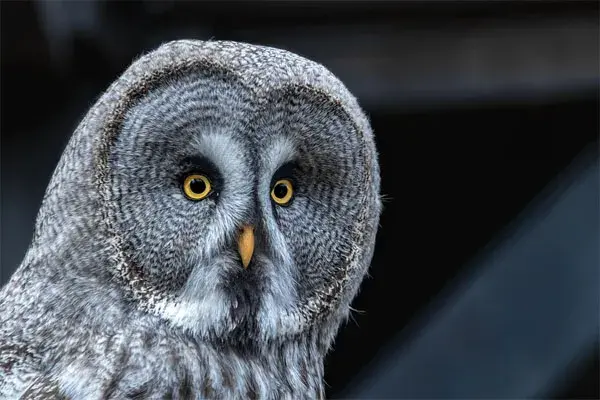
- Scientific Name: Strix nebulosa
- Length: 24-33 in
- Weight: 1.2-4 lb
Great gray owls are the largest species of owls in the world by length and measure from 24 to 33 inches long. They are known under several names, including Phantoms of the North, bearded owls, sooty owls, etc.
Great gray owls are found in Europe, Asia, and North America, usually around coniferous forests, meadows, and bogs. In the USA, they can be spotted in Michigan.
Great gray owls have forward-facing eyes on their large round heads. The eyes have yellow-colored irises with darker circles around them.
Great gray owls are a very rare species that hunt around dusk and dawn, mostly on voles. Although mostly silent, solitary, and stealthy, these raptors have been known to drive off predators as large as black bears when defending their nests.
12. Northern Boobook
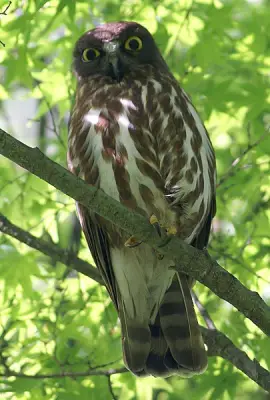
- Scientific Name: Ninox japonica
- Length: 12.6 in
- Weight: 5.9-8.8 oz
Northern boobooks are native to eastern and southern countries of Asia. They were once considered a subspecies of brown boobooks and despite being one of the most common breeding owls in Japan, there haven’t been too many studies of the species.
These medium-sized owls with very expressive golden-yellow eyes are dark brown above and white below with long dark streaks on their breasts. Unlike other owl species, northern boobooks lack ear tufts and facial disks.
They inhabit different forests, including lowland deciduous forests, coniferous forests, parks, gardens, plantations, and even swamps. Identify them also by their sharp “heeoo,” quiet “kerr,” and cat-like “mew” calls. Northern boobooks are carnivores and mainly feed on insects, bats, some lizards, and small birds.
13. Boreal Owl
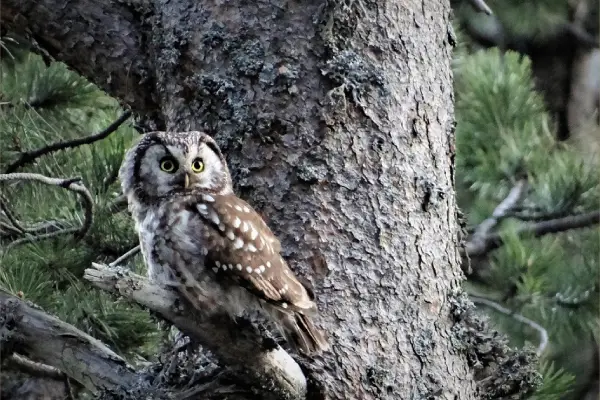
- Scientific Name: Aegolius funereus
- Length: 8-11 in
- Weight: 3-7 oz
Boreal owls are small owls found in Europe, Asia, and North America. They are common in boreal, highland, and mixed woodlands, where they nest in tree holes, hunt during the night, and roost during the day, staying well-camouflaged in dense vegetation.
Boreal owls are also known as Tengmalm’s owls (after Swedish naturalist Peter Gustaf Tengmalm) and can be identified by their dark brown upperparts, white spots on backs and rumps, conspicuous facial disks, yellow hooked beaks, and yellow eyes.
Males make a series of deep “po-po” hoots during the breeding season while females make aggressive “kwahk” calls. Similar to other owls, these large-headed raptors feed on voles, lemmings, mice, moles, frogs, birds, bats, and insects. Because of their evasive nature, nocturnal activity, and hard-to-access habitats, boreal owls might be hard to spot.
They do not have a very long life either, reaching only 7 or 8 years of age.
14. Short-eared Owl

- Scientific Name: Asio flammeus
- Length: 13-17 in
- Weight: 7.3-16.8 oz
Short-eared owls are found on all continents except Antarctica and Australia, making them one of the most widespread bird species. These medium-sized owls are mottled brown above, whitish below, and have very short ear tufts and black beaks.
Short-eared owls also have large yellow eyes that are accentuated by black rings, making them look like they are wearing mascara! Although mostly silent, short-eared owls will make a series of “voo-hoo-hoo” calls during the breeding season.
They are found in the open country, around marshes, grasslands, montane forests, tundras, and savannas. Short-eared owls are migratory birds that feed mostly on voles, rats, bats, mice, squirrels, rabbits, and some birds.
Fun Fact: Short-eared owls are fearless birds that will often harass falcons, herons, and eagles, just for fun!
15. Snowy Owl
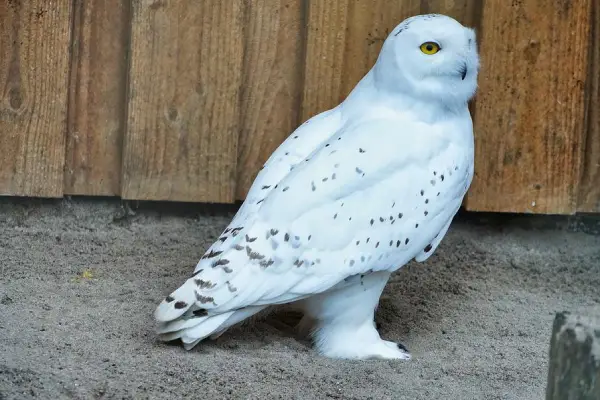
- Scientific Name: Bubo scandiacus
- Length: 21-28 in
- Weight: 2.9-6.5 lb
Snowy owls are huge white birds that rank among the largest owls in the world. They are also the only white owls in the world and can weigh as much as 6.5 pounds!
Snowy owls have extremely large yellow eyes that are around 0.92 inches in diameter – this is slightly smaller compared to great horned and Eurasian eagle owls but bigger compared to great gray owls.
Snowy owls sleep at night, hunt during the day, and have a diet that includes small mammals, some water birds, fish, and even carrion. Their favorite food is lemmings (small mouselike rodents) – snowy owls might hunt as much as 1,600 of those per year. These beautiful birds are monogamous and mate for life.
Snowy owls are also one of several white-colored birds of prey.
Summary
Owl eyes have captivated humans for centuries. Yellow eyes add to their overall beauty and help them detect any movement before grabbing their prey. Some examples include snowy owls, great gray owls, and boreal owls.
Read More: Owls that have dark eyes